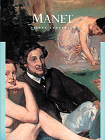Manet
Manet's far reaching influence on French painting and the general development of modern art was due to his portrayal of everyday subject matter; his use of broad simple colour areas; and a vivid summary brush technique. These techniques allowed Manet to flatten out the picture plane, and it became a surface rather than an illusion like the Academic paintings.
Manet's early masterpieces varied widely in subject and artistic approach, but most of them reflected Manet's interest in the contemporary scene -- and all were either ignored or rejected by the art public. "The Absinthe Drinker" (1858) was criticized because it made no effort to sentimentalize the subject's unsavory condition. Contemporary subjects were not in themselves taboo, but Manet's moody treatment, his indistinct outlines and background - in short, his unacademic approach - offended the public eye. Critics were often put off by the eccentric colouring, by the flat perspective and by the contrasts between tradition and innovation that often fond their way into his work.
If "The Absinthe Drinker" compared to Couture's "Rome in her Decline" (1847), which is an Academic history painting, it is truly a scandal. "Absinthe" is much more direct scene, a portrait of a drunken man. "Absinthe" depicted the figure from direct observation, in a simple, sketch-like style. The history painting on the other hand, showed the conception in heroic and monumental form; it is large in scale, composed in Renaissance arrangement, and highly finished.
Manet, the first Modernist, enabled the viewer to see the paint itself as an element in the painting and to see the texture, colour elements. In "Music in the Tuileries Garden" (1862), Manet applied a sketch-like technique, the paining looked unfinished with invisible brush marks, it showed no detail on figures' face, which are represented by a couple of brushstrokes. But this approach achieved movement, the scene is like taking place in front of our eyes.
Manet refused to adopt the same rules as the Academic painter. He represented the world without message, his work looked natural, with no composed arrangement. In "The Execution of the Emperor Maximillian" (1867), there is no heroic performance, it is a plain recording of a reality, it showed no arrangement, or meaningful order. Manet is interested in the soldiers as subject to be painted. When it compared to Goya's "Execution of 3rd May" (1808), which is compositionally arranged with the focus aimed at the central figure, shows a heroic sacrifice, Manet's version is controversial in the treatment of a tight-lipped subject. He had been accused as cold-blooded for such an emotionless image.
Manet began to get rid of half-tone in his paintings, which in turn flatten out the image. For example, "The Spanish Singer" (1862) showed no fine modeling, it used simple tone to suggest the change of plane, it emphasized the image as a surface rather than a space. In "Portrait of Emile Zola" too, the space is reduced to shallow platform. The shallow space is achieved by depicting Zola sit against the wall, with the Japanese print, manuscript, and drawing all being paralleled to the picture plane, so they would not penetrate the plane.
Manet continued to explore the reduction of space. He found encouragement form Japanese woodcuts, as they brought proof that you could dispense with perspective and limit yourself to flat colours and lines and still do justice to the subject matter. Manet explored these ideas further and came up with "The Fifer" (1866), a flat figure silhouetted on a flat background. It was a striking illustration.
"Le Dejeuner sur l'herbe" (1863), portraying a woodland picnic that included a seated female nude attended by two fully dressed young men, was bitterly attacked by the critics. For this painting, Manet executed some sketches outdoors but painted the picture in his studio in such a way that the figures and the landscape appear disconnected. Lighting is not consistent, the studio light falling upon the central group alone, where the landscape had a delicate, outdoor atmosphere. Manet painted the female nude in a contemporary manner that makes her look almost pasted onto the landscape. "Dejeuner sur l'herbe" also had a shallow space, the figures had no foreshortening in limbs, no modeling in the woman, and the background acted like a backdrop.
Manet's "Olympia" (1863) shocked the public, this is not due to the subject matter, as "Olympic" showed resemblance to Titian's "Venus of Urbino" and Goya's "Naked Maja", but in his unfamiliar style. It reveals Manet's will to simplify. Manet visualized brushwork and emphasized on the flat surface pattern, he guided the viewer to see the merely pigment on a piece of canvas. He even underscores its intervention with a thick, blackish outline that encompasses the figure of Olympia. Manet forces the viewer to see Olympia's not only as a naked girl, but also as patches of paint laid on the surface of the canvas.
Manet noticed the reduction to the pictorial space marks the real beginning of modern painting. In "Olympia", with a bold girl in the new pictorial space, Manet forces the viewer to fill out the emotional context and to create in his mind's eye the whole three dimensional setting. It is this that stunned his audience, and this that makes the picture modern.
Recommended Reading(s):


Back to top
Back to Home



